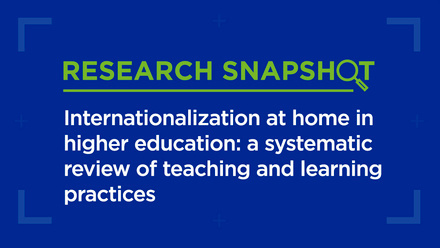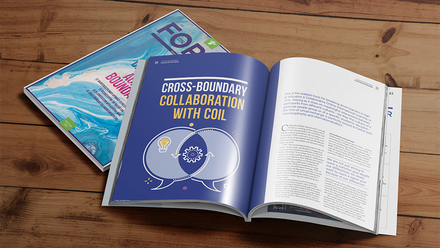COIL: what’s in an acronym?

The biggest benefits from traditional mobility generally appear to be in attitudes, self-confidence, ability to adapt and ability to cooperate with different kinds of people. This is usually explained by the effect of being ‘exposed’ to different situations, contexts and people, and being ‘forced’ to adapt in order to achieve positive outcomes, in both academic and non-academic terms.
Bearing this in mind, it seems logical that ‘virtual mobility’ or ‘virtual exchange’ activities should be designed in a way to reproduce this profound effect of ‘exposure’. The model of Collaborative Online International Learning (COIL) has been developed over the last 15 years to do just that, and to offer similar or better outcomes than physical mobility in terms of improved international and intercultural competences. Typically, the COIL model is applied to a course or part of a course within a larger degree programme (a ‘COIL module’).
Four criteria: C-O-I-L
In order to qualify as COIL, activities must absolutely meet the cumulative conditions of being:
• Collaborative: staff are co-teaching the module on equal footing; students are put in a position of needing to cooperate effectively and efficiently to produce the required outputs of the activity.
• Online: the interaction between the students and staff in question takes place (mostly or exclusively) online.
• International: there is meaningful interaction between staff and students in two (or more) different countries, leading to the development of international and intercultural competences.
• Learning: COIL modules are learning activities, and should be an integral part of the curriculum, not an optional and inconsequential ‘extra’.
In summary, only if a teaching activity fits all of these characteristics should it be recognised as constituting true ‘virtual exchange’. The four conditions above are cumulative and strict.
Once these criteria are met, COIL modules can take many different shapes and sizes. COIL modules could also be used as a complement to short-term physical mobility for the staff and/or students involved, together constituting ‘blended mobility’. For example, there could be an ‘international project week’ where the students and staff physically meet, in addition to their longer-lasting online collaboration; in any case it is very beneficial that the staff members involved in a COIL module should meet physically in the planning phase in order to build the trust necessary for co-teaching.
Assuring high-quality COIL
In order to have effective COIL modules, it is essential for the concept to become solidly embedded in the institution, rather than simply remaining an initiative of an individual staff member. COIL should be recognised as an essential form of internationalisation at all levels in the institution.
If done well, people from many parts of the institution will need to contribute their skills, expertise and time. Teaching staff will need to redesign their course modules, rethinking both contents, learning outcomes, delivery, teaching materials, assignments etc, all in view of online co-teaching with an international partner. This will require significant extra investment of time, certainly at the beginning.
COIL is not a cheap or easy alternative to traditional mobility – for it to flourish, solid institutional embeddedness, recognition and support are required
Teachers will need intensive support from specialised staff for educational methodology (instructional designers, teaching and learning specialists). The COIL methodology is well developed: over the past 15 years, protocols, failures and good practices have been thoroughly documented. Support staff within the institutions should be well trained on COIL, its key concepts, methodologies, resources and do’s and don’ts. In turn, they will then be able to give the kind of support to teaching staff needed to maximise the chances of a successful COIL implementation and to avoid the many pitfalls which come with the structural limitations of online interaction.
Even though educational questions certainly come first when it comes to COIL, efficient use of technology is also a necessary condition. In order to avoid communication breakdowns and frustrations, good technological support must be available at all times.
Finally, COIL modules necessarily involve strong international partnerships between universities. Specialists in international offices should support their faculty in setting up and managing the right international partnerships for their COIL modules.
Ensuring recognition of COIL activities
Once you’ve got good COIL modules up and running at your institution, the final step is making sure that it all counts for something. In this context, ‘recognition’ can mean two things:
At the level of the individual student: how do we make sure the activities undertaken during ‘virtual mobility’ (ie, as part of a COIL module) are recognised within their curriculum and are awarded credits? In this regard, the COIL model can be quite simple: since the COIL module is carried out in constant cooperation between the two (or more) professors and their respective students, the students can in fact stay under the formal authority of their home professor at all times. There is no need to create a formal ‘joint course’ with shared authority over the entire group, although this is a possibility. The simple solution is that the credits and grades be simply awarded by the home institution of the student.
At the institutional level or supra-institutional level: how can ‘virtual mobility’ be recognised, measured and potentially funded? In the case of COIL modules, this could simply be accounted for and quantified as follows:
- Confirmation that the activities a specific professor is undertaking within their course or module meet the four basic conditions listed above (collaborative, online, international, learning). This could be documented in a work plan.
- Calculation of: number of students involved, number of credits (how large is the part of the course taken up by the COIL activities in terms of student workload? For example, within a 6 ECTS course, half of the student’s workload is directly related to the COIL activities, thus 3 ECTS credits). This calculation could serve as a basis for awarding financial and other support.
While ‘virtual mobility’ and ‘virtual exchange’ may be rather vague concepts, the COIL model provides a well-defined and proven methodology for bringing international and intercultural into the core curriculum for all students. However, COIL is not a cheap or easy alternative to traditional mobility. For it to flourish, solid institutional embeddedness, recognition and support are required. Its success and sustainability will depend on the continued dedication and cooperation of many different actors in the institutions involved.






